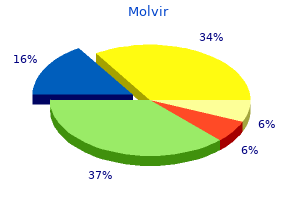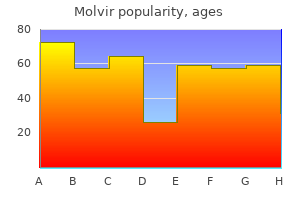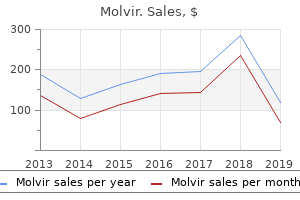Molvir
"Cheap molvir online amex, hiv infection rates heterosexuals".
By: N. Milten, M.B. B.CH. B.A.O., M.B.B.Ch., Ph.D.
Co-Director, Edward Via College of Osteopathic Medicine
Peak onset of respiratory despair after an analgesic dose of morphine is slower than after comparable doses of fentanyl new hiv infection symptoms molvir 200mg sale, and respiratory depression induced by small doses of morphine often lasts longer than after equipotent doses of fentanyl hiv stages of infection buy molvir 200 mg. With larger doses of fentanyl (50 to one hundred g/kg) hiv infection cycle diagram buy molvir in united states online, respiratory melancholy can persist for many hours hiv infection mouth ulcers order molvir overnight delivery. When reasonably large doses (20 to 50 g/kg or greater) of fentanyl are used, the potential want for postoperative mechanical air flow should be anticipated. However, reviews have noted naloxone-resistant respiratory depression after intrathecal morphine administration. The nucleus solitarius and parabrachial nucleus play an important position within the hemodynamic management of vasopressin secretion. Enkephalin-containing neurons and opioid receptors are distributed in these areas. The predominant and traditional impact of opioids on heart price is bradycardia ensuing from stimulation of the central vagal nucleus. Blockade of sympathetic actions may play a task in opioid-induced bradycardia. Meperidine, in distinction to different opioids, rarely ends in bradycardia, but it could cause tachycardia. Older sufferers are extra sensitive to the anesthetic and respiratory depressant effects of opioids (see additionally Chapter 80). Older sufferers additionally experience greater plasma concentrations of opioids administered on a weight foundation. Morphine can produce higher respiratory despair on a weight foundation in neonates than in adults as a result of morphine simply penetrates the brain in neonates and infants with incomplete blood-brain obstacles. Although opioid motion is usually dissipated by redistribution and hepatic metabolism, somewhat than by urinary excretion, the adequacy of renal operate could influence the duration of opioid exercise. In renal insufficiency, the respiratory depressant properties of the morphine metabolite M6G would turn into evident because it accumulated. Hypocapnic hyperventilation enhances and prolongs postoperative respiratory melancholy after fentanyl (10 and 25 g/kg). In patients who hyperventilate because of anxiousness or ache, even small doses of intravenous opioids can end result in transient apnea because of acute shifts in apneic thresholds. Mechanisms for this phenomenon could embody augmented release of fentanyl or different opioids from skeletal muscle into the systemic circulation on rewarming, shivering, movement, or any other situation that enhances muscle perfusion. Contractility Morphine decreases Ca2+ transients however not cardiac contraction and enhances myofilament Ca2+ sensitivity via the motion on the 1-opioid receptor expressed within the heart. Possible mechanisms of the dose-dependent constructive inotropic results of fentanyl, as properly as those of sufentanil, embody catecholamine release or direct myocardial adrenergic activation. In canine, remifentanil produced hemodynamic effects that include decreases in contractility and cardiac output, as well as reductions in coronary heart price and blood strain. In an experimental mannequin of myocardial ischemia in rabbits, fentanyl had antiarrhythmic and antiischemic action with central and peripheral opioid receptor involvement. Opioid receptor stimulation results in a reduction in infarct size similar to that produced by ischemic preconditioning. The myocardial -opioid receptors had been demonstrated to mediate cardioprotection by remote preconditioning. This phenomenon, termed postconditioning, was proven to be induced by activation of the -opioid receptor within the heart. This anestheticinduced postconditioning could be enhanced by morphine through the activation of phosphatidyl-3-kinase and opioid receptors. However, some reviews have famous direct effects of opioids on cardiac pacemaker cells. Alfentanil considerably decreased the frequency of contractions of the best atrial-sinoatrial node in a doserelated manner in isolated cardiac tissues from young grownup rabbits. Periods of asystole, 10 to 12 seconds in length, could resolve spontaneously, however they often reply to atropine (0. Fentanyl may depress cardiac conduction by a mechanism mediated by direct membrane actions, versus opioid receptor interactions. Naloxone, morphine, and levorphanol protected in opposition to arrhythmia induced by coronary artery occlusion in rats. This baroreflex control is enhanced by low plasma concentrations of Chapter 31: Opioid Analgesics 881 fentanyl (1 to 2 ng/mL), nevertheless it appears to be depressed with increasing plasma concentrations of fentanyl. Circulatory Reflexes In an experiment examining baroreceptor reflex responses induced by perfusion of the carotid sinus at predetermined levels, baroreceptor reflexes were nicely preserved with reasonable doses of fentanyl, whereas high doses of fentanyl depressed the baroreceptor reflexes.

The formation of synapses then leads to hiv infection probability molvir 200 mg sale neuronal maturation and creation of circuitries by way of processes which are tightly controlled by the glial cells hiv infection rates san francisco cheap molvir 200mg on line. Glia actively talk with neurons whereas offering a nurturing milieu for neuron-neuron interactions hiv infection rate by state cheap 200mg molvir overnight delivery. Studies suggest that anesthesia-induced activation of the intrinsic pathway occurs earlier than activation of the extrinsic pathway acute hiv infection symptoms pictures generic molvir 200 mg mastercard. Although normal, apoptosis throughout improvement is tightly managed, resulting in the removing of only a small proportion of neurons. General anesthetics do trigger significant and widespread neuroapoptotic degeneration of growing neurons in various mammalian species, together with mice,8,9 rats,7 guinea pigs,10 piglets11 and nonhuman primates12-14. The peak of vulnerability to anesthesiainduced neuroapoptosis in each species coincides with its peak of synaptogenesis, with a lot less vulnerability noticed throughout late levels of synaptogenesis. Neurotrophic Factor�Dependent Apoptotic Cascade the neurotrophins, a family of neuronal progress components, assist neuronal survival and differentiation and synaptic plasticity. Neurotrophins are synthesized and released by neurons; both their biosynthesis and secretion rely upon neuronal activity. Extensive despair of neuronal exercise can impair neurotrophin-regulated survival-promoting signals and consequently promote apoptosis. A intercourse hormone, -estradiol, offers some protection in opposition to the anesthetic-induced neuroapoptosis by partially inhibiting anesthesia-induced caspase-3 activation. Careful quantification of neuronal densities in essentially the most weak cortical and subcortical regions revealed that animals handled with general anesthesia had as much as a 50% lower in neuronal densities in these mind regions in contrast to untreated animals. Perhaps clinical doses of anesthetic jeopardizes the survival of such an extra of developing neurons. Accordingly, basic anesthesia administered at the peak of synaptogenesis prompts the mitochondria-dependent cascade within 2 hours and is characterised by a lower in Bcl-xL, an increase in cytochrome c, and activation of caspase-9. Thus, a variety of the preclinical findings may be a result of inadequate upkeep of physiologic homeostasis. Panels a to l are mild micrographs of assorted mind areas of a control rat (a, f, h, j) and a rat exposed to isoflurane (0. Some sections were stained by the de Olmos silver technique (a, b, d, f, g, k); the others were immunocytochemically stained to reveal caspase-3 activation (c, e, h to j, l). The cell in m shows an early stage of apoptosis during which dense chromatin balls type in the nucleus while the nuclear membrane stays intact. The cell in n reveals a a lot later stage of apoptosis during which the whole cell is condensed, the nuclear membrane is absent, and intermixing of nuclear and cytoplasmic constituents is seen. These research verify the smaller animal research, suggesting that the histomorphologic modifications observed are caused by basic anesthesia per se and never by hypoxia, hypercarbia, or metabolic imbalance. Moreover, neither hypoglycemia9 nor hypercarbia20 considerably worsens anesthesia-induced developmental neuroapoptosis, again implicating the anesthetic as opposed to the physiologic state. Thus, general anesthetics may disturb this nice dynamic steadiness, favoring mitochondrial fusion. Such dysfunction may be the cause of anesthesiainduced developmental neurodegeneration,21 especially as a end result of an imbalance that favors fusion could contribute to a quantity of adult neurodegenerative ailments. This vulnerability, mixed with a high polyunsaturated fatty acid content, makes them vulnerable to extreme lipid peroxidation and mobile injury. Administration of either radical scavengers or mitochondrial permeability transition pore blockers with anesthetics at postnatal day 7 (the peak of synaptogenesis) prevented the development of learning and reminiscence impairment as adolescents. Moreover, melatonin, a naturally occurring sleep hormone,sixteen and carnitine, a nutritional supplement that protects mitochondrial integrity,35 trigger vital protection against neuronal apoptosis. Thus, preventing excessive lipid peroxidation and protecting mitochondria may be the key to safe use of basic anesthesia during early stages of brain improvement. Desflurane and sevoflurane, but less so propofol, activate the InsP3R and with comparable consequences. Moderate will increase in endoplasmic reticulum calcium launch could provide neuroprotection,39 whereas extreme release may push calcium into the toxic vary. As a second messenger, intracellular calcium regulates many features of neuronal development, including synapse formation and function, membrane excitability, protein synthesis, neuronal apoptosis, and autophagy- all necessary parts of neuronal survival. The course of for clearing this debris with out causing harm to the neuron is the multistep process, autophagy. Autophagy is initiated by the formation of autophagosomes, double-membrane�bound cellular buildings that enter lysosomes, the acidic vacuolar compartment that contains varied lytic enzymes.

In trauma patients hiv infection australia buy molvir 200mg without prescription, a 1-hour creatinine clearance of less than 25 mL/minute decided within 6 hours of surgery reliably predicted postoperative acute renal failure hiv infection numbers world buy molvir online now, regardless of the absence of oliguria antiviral juice recipe discount generic molvir uk. Tobias and associates45 reported a variation in creatinine clearance between 88 and 148 mL/ minute and in serum creatinine between zero anti viral hpv buy cheap molvir 200 mg on line. There can also be a diurnal variation, with greater values within the afternoon and a variance of as much as 25% round mean values. Creatinine clearance has a variety of inherent limitations, even if collection error is carefully avoided. However, information from the 2-hour collection can be found well earlier than those from the 22-hour collection. A preoperative creatinine clearance can provide a baseline for comparability with postoperative changes and in addition give a extra correct measure of effective renal reserve. Postoperatively, daily measurement of creatinine clearance is beneficial in guiding the dosing of renally excreted, doubtlessly nephrotoxic aminoglycoside antibiotics (gentamicin, tobramycin, amikacin) or calcineurin antagonists (cyclosporine A, tacrolimus). Directional adjustments between creatinine clearance and inulin clearance present good agreement. Patient with renovascular hypertension and renal insufficiency admitted to the intensive care unit for preoperative monitoring and stabilization. Bilateral renal revascularization was performed, and following return from the working room there was a considerable decline in renal perform. However, widely used medication such as trimethoprim, H2-antagonists, and salicylates block tubular secretion of creatinine and may elevate serum creatinine and reduce creatinine clearance. Given these constraints, an isolated creatinine clearance estimation might not reveal early renal dysfunction. It entails an intravenous bolus dose and/or infusion of the marker, followed by measurement of a quantity of plasma levels to calculate its disappearance fee. In this case, evaluation of urea dealing with is a more dependable indicator of a prerenal state. However, if intravascular hypovolemia is sufficiently extreme, tubular sodium retention and low urinary sodium might persist regardless of the administration of diuretics corresponding to small-dose dopamine. However, in nonoliguric renal failure, which accounts for as a lot as 75% of instances of acute tubular necrosis encountered clinically,fifty one the changes in tubular function are much less distinct from these of the prerenal syndrome. Normally, about 98% of water is abstracted, and urine creatinine is way higher than plasma creatinine. For example, assume that two patients have oliguria with a serum creatinine elevated to 2. Patient A probably has a prerenal state, because tubular water abstraction is excessive (U:P creatinine = 50:1), whereas affected person B probably has acute tubular necrosis, because tubular water abstraction is impaired (U:P creatinine = 10:1). Urine-to-Plasma Osmolar Ratio the traditional tubular response to dehydration or hypovolemia is to concentrate the urine and improve urine osmolality above 450 mOs/kg, compared with a normal serum or plasma osmolality of 280 to 300 mOs/kg. However, isosthenuria could be induced in a prerenal state when diuretics are administered (see earlier). However, in two situations, severe sepsis and the hepatorenal syndrome of liver failure, refractory oliguria with low urine sodium persists despite aggressive fluid resuscitation. The pathogenesis is multifactorial, but frequent to each syndromes is endotoxemia, which induces renal vasoconstriction and avid tubular sodium reabsorption. In established acute renal failure, the tubular ability to conserve sodium and shield the intravascular quantity is lost, and urine sodium exceeds 60 to 80 mEq/L. In essence, free water is cleared by the tubules in response to hypervolemia ("optimistic free water clearance"), or retained in response to hypovolemia ("adverse free water clearance"). In troublesome conditions, a combination of tests is much less prone to be topic to error than is a single estimation. Their widely acknowledged limitations in the early and accurate detection of evolving renal injury have fostered an rising curiosity in a new technology of biomarkers. Functional genomics and proteomics have created the chance of identifying potential damage biomarkers with a precision and specificity not beforehand possible, and numerous candidate biomarkers are at present at varied phases of medical investigation.
In cases of hypovolemia hiv infection among youth cheap molvir 200 mg without a prescription, the power to recruit unstressed quantity is diminished (or even absent hiv infection probability purchase line molvir, as a outcome of unstressed quantity has been completely mobilized) hiv infection due to blood transfusion cheap molvir american express, and an increase in blood strain may be achieved solely by administration of large doses of -adrenergic agonists hiv infection how purchase molvir 200 mg online, which would lead to constriction of arteries, reducing tissue blood flow, and tissue ischemia; therefore, the hypovolemia should be resolved as quickly as attainable. The latter is reinforced by concomitant constriction of splanchnic veins; both lead to passive and active expulsion of blood from the splanchnic venous system. General anesthesia impairs this reflex and considerably modifies such responses, decreasing the power of the body to compensate for modifications in blood strain. Such an motion is associated with a lower in plasma volume and a rise in hematocrit values. In conclusion, completely different mediators regulate the blood flow and filtration of fluid throughout the spleen, usually leading to an increase within the filtration of fluid and a rise in hematocrit values within the splenic venous blood. This lower results in a passive recoil of the splanchnic veins and a shift of blood quantity from the splanchnic system into systemic circulation. Associated surgical stress and an increase in sympathetic discharge add an active component of venoconstriction. This is why in experimental situations the clamping of the aorta at the diaphragmatic stage is most frequently associated with an increase in venous return and cardiac output. A few examples are totally different depths of anesthesia, blood loss, and concomitant use of vasoactive medication, including epidural anesthesia. Second, this quantity often shifts into the extra compliant splanchnic veins (increasing the unstressed volume) rather than to the guts, which might improve venous return. This is why, even with out serious blood loss, clamping of the aorta distal to the arteries supplying blood to splanchnic organs usually decreases cardiac output. Effects of Increased Intra-abdominal Pressure on Gastrointestinal Blood Flow and Splanchnic Blood Volume Spontaneous inspirations are associated with shifts of the diaphragm downwards, compression of the splanchnic vasculature, and shift of blood volume from the splanchnic system into the systemic circulation. During expiration the diaphragm shifts upwards, reducing the flow from the splanchnic veins and rising flow from the legs. More drastic will increase in intra-abdominal pressure occur during different physiologic actions, such as defecation, coughing, and physical train. Acute nonphysiologic increases occur during hemorrhage, perforation of a hollow organ throughout the belly cavity, pneumoperitoneum, and other abnormal states. Some conditions corresponding to being pregnant and accumulation of ascites are associated with a comparatively slow increase in intra-abdominal pressure. A drastic enhance in intra-abdominal stress might lead to abdominal compartment syndrome, which presents as a life-threatening hemodynamic instability and normally occurs when intra-abdominal stress exceeds 25 mm Hg. Pneumoperitoneum induced for laparoscopic surgical procedure decreases blood move via the intra-abdominal organs. Any circulate through the hepatic veins is maintained by the confused blood quantity throughout the splanchnic vasculature. In different phrases, the intravascular stress inside the splanchnic system must be higher than the intra-abdominal pressure, which is the perivascular strain. When intra-abdominal strain starts to increase, intravascular strain will increase with it, and confused volume flows out of the splanchnic system through the hepatic veins, elevating the intra-abdominal strain by 5 mL/cm of fluid. A simultaneous enhance in pressure throughout the inferior caval vein on the level of hepatic veins momentarily stops blood circulate via the femoral veins. However, that high strain also increases circulate from the hepatic vein entry and delays the compression of the inferior caval vein by high intra-abdominal stress. This increased strain gradient from the inferior caval vein pressure to the proper atrial stress increases circulate via the inferior caval vein and venous return, helping to counteract the effects of the compression of the inferior caval vein and attainable lower in preload. Thus, a rise in stressed volume is needed to overcome the rise in impedance to the venous return. Mean arterial stress is usually barely elevated or decreased, cardiac output might be decreased or maintained. This scheme depicts the explanation for the decrease in venous capacity, which leads to blood volume redistribution from the vasculature distal to aortic occlusion to the vasculature proximal to aortic occlusion. If the aorta is occluded above the splanchnic system, the blood quantity travels to the guts, growing preload and blood quantity in all organs and tissues proximal to the clamp.
Purchase molvir 200 mg visa. HIV Positive Youth - Let's talk Stigma.


